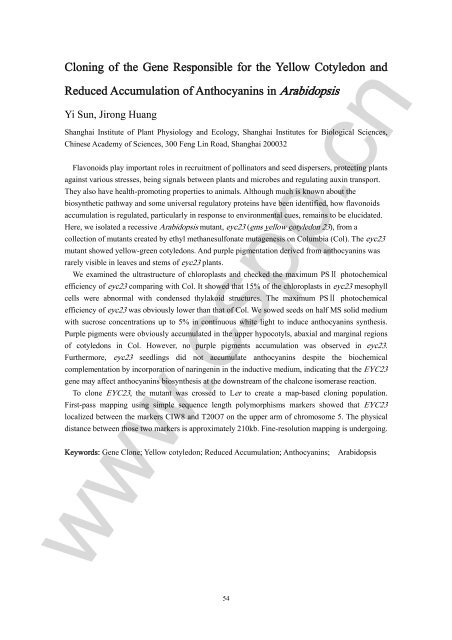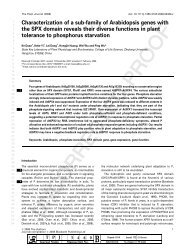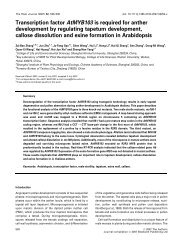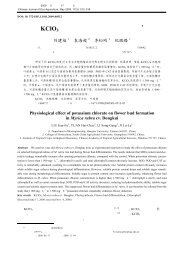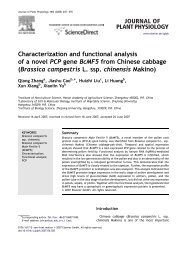Untitled - ä¸å½æ¤ç©ççä¸ååçç©å¦å¦ä¼
Untitled - ä¸å½æ¤ç©ççä¸ååçç©å¦å¦ä¼
Untitled - ä¸å½æ¤ç©ççä¸ååçç©å¦å¦ä¼
You also want an ePaper? Increase the reach of your titles
YUMPU automatically turns print PDFs into web optimized ePapers that Google loves.
Cloning of the Gene Responsible for the Yellow Cotyledon and<br />
Reduced Accumulation of Anthocyanins in Arabidopsis<br />
Yi Sun, Jirong Huang<br />
Shanghai Institute of Plant Physiology and Ecology, Shanghai Institutes for Biological Sciences,<br />
Chinese Academy of Sciences, 300 Feng Lin Road, Shanghai 200032<br />
Flavonoids play important roles in recruitment of pollinators and seed dispersers, protecting plants<br />
against various stresses, being signals between plants and microbes and regulating auxin transport.<br />
They also have health-promoting properties to animals. Although much is known about the<br />
biosynthetic pathway and some universal regulatory proteins have been identified, how flavonoids<br />
accumulation is regulated, particularly in response to environmental cues, remains to be elucidated.<br />
Here, we isolated a recessive Arabidopsis mutant, eyc23 (ems yellow cotyledon 23), from a<br />
collection of mutants created by ethyl methanesulfonate mutagenesis on Columbia (Col). The eyc23<br />
mutant showed yellow-green cotyledons. And purple pigmentation derived from anthocyanins was<br />
rarely visible in leaves and stems of eyc23 plants.<br />
We examined the ultrastructure of chloroplasts and checked the maximum PSⅡ photochemical<br />
efficiency of eyc23 comparing with Col. It showed that 15% of the chloroplasts in eyc23 mesophyll<br />
cells were abnormal with condensed thylakoid structures. The maximum PSⅡ photochemical<br />
efficiency of eyc23 was obviously lower than that of Col. We sowed seeds on half MS solid medium<br />
with sucrose concentrations up to 5% in continuous white light to induce anthocyanins synthesis.<br />
Purple pigments were obviously accumulated in the upper hypocotyls, abaxial and marginal regions<br />
of cotyledons in Col. However, no purple pigments accumulation was observed in eyc23.<br />
Furthermore, eyc23 seedlings did not accumulate anthocyanins despite the biochemical<br />
complementation by incorporation of naringenin in the inductive medium, indicating that the EYC23<br />
gene may affect anthocyanins biosynthesis at the downstream of the chalcone isomerase reaction.<br />
To clone EYC23, the mutant was crossed to Ler to create a map-based cloning population.<br />
First-pass mapping using simple sequence length polymorphisms markers showed that EYC23<br />
localized between the markers CIW8 and T20O7 on the upper arm of chromosome 5. The physical<br />
distance between those two markers is approximately 210kb. Fine-resolution mapping is undergoing.<br />
Keywords: Gene Clone; Yellow cotyledon; Reduced Accumulation; Anthocyanins;<br />
Arabidopsis<br />
www.cspp.cn<br />
54


